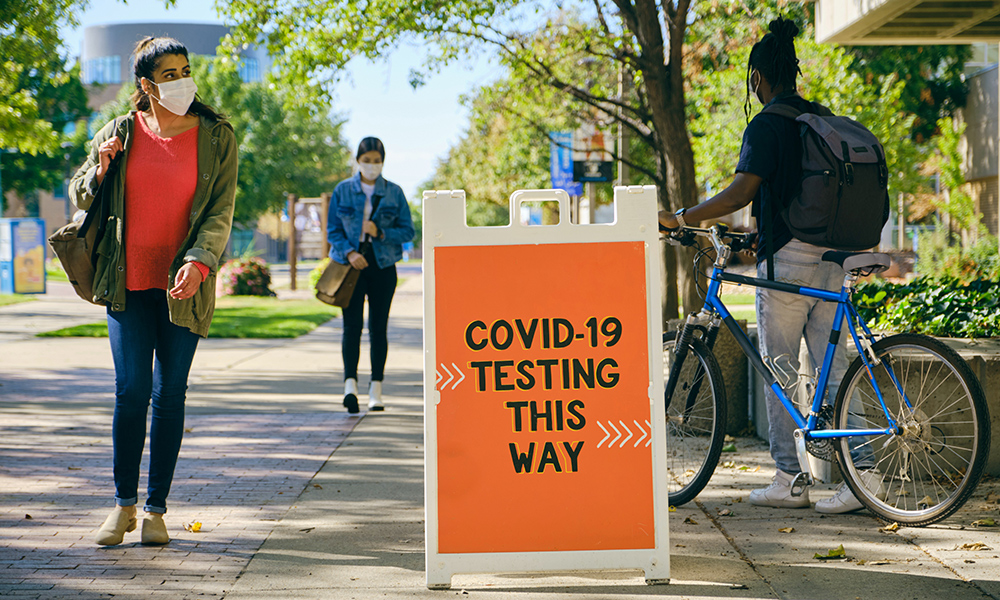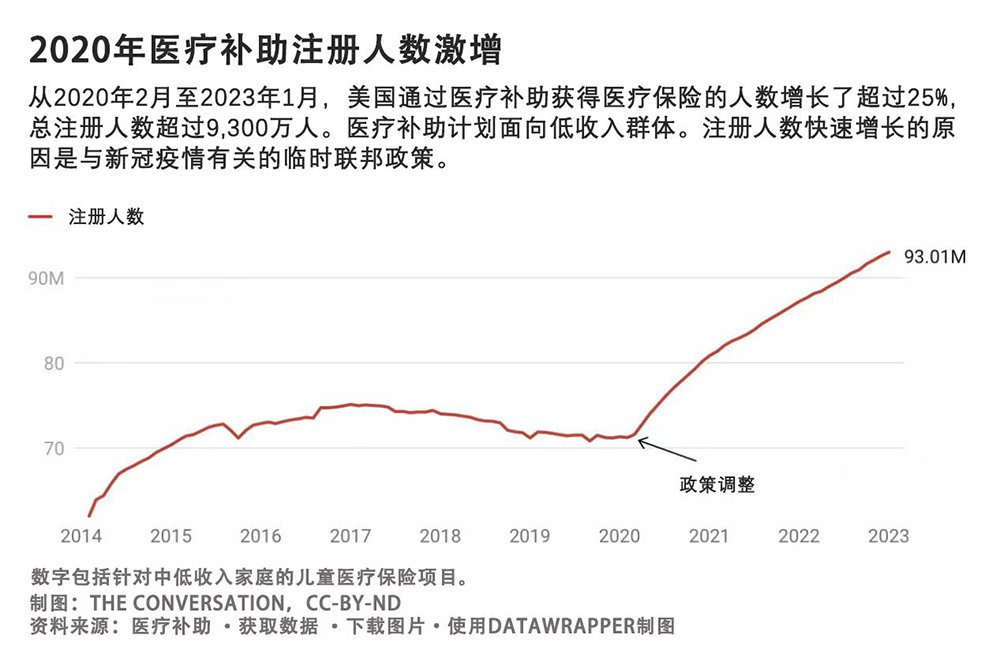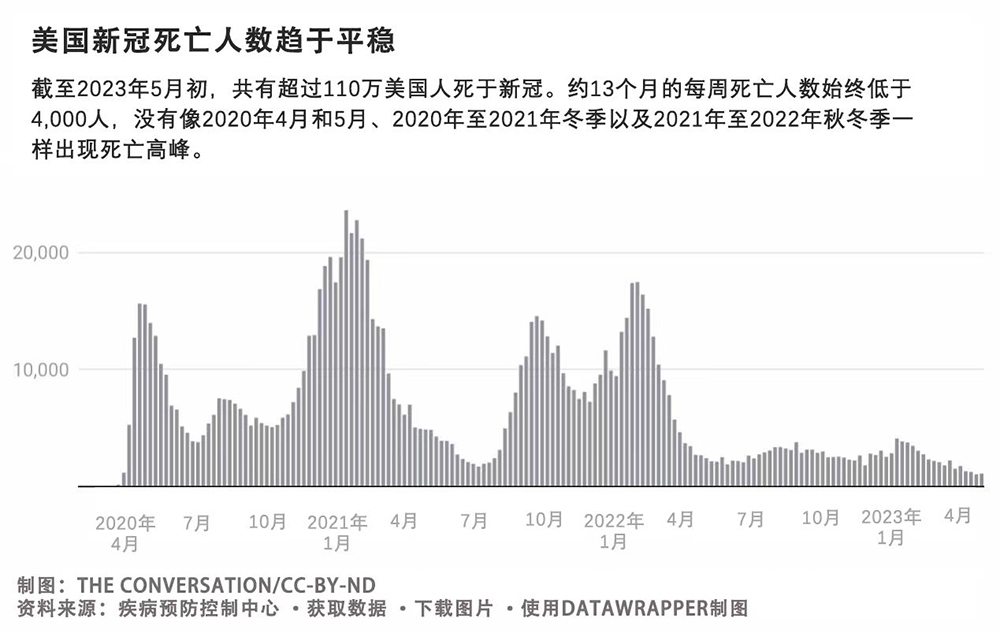
美國在2023年5月11日結束新冠疫情公共衛生緊急狀態。5月5日,世界衛生組織(World Health Organization)宣布新冠疫情不再構成“國際關注的公共衛生緊急事件”(簡稱PHEIC)。世衛組織從2020年1月30日起將新冠疫情定性為國際關注的公共衛生緊急事件。
但無論世衛組織還是白宮都明確表示,雖然疫情緊急狀態已經結束,但病毒并沒有消失,可能繼續造成嚴重破壞。
世衛組織總干事譚德塞指出,根據報告病例統計,新冠病毒在美國造成超過100萬人死亡,在全球造成約700萬人死亡,但他表示全球實際死亡人數可能接近2,000萬人。他表示,雖然新冠疫情全球緊急狀態已經結束,但依舊是一個“既定且持續的健康問題”。
The Conversation采訪了公共衛生專家瑪麗安·莫澤·瓊斯和埃米·勞倫·費爾柴爾德,分析這些變化的大背景,并解釋了它們對下一階段疫情的影響。
1. 結束全國疫情緊急狀態意味著什么?
美國結束聯邦緊急狀態,表明從科學和政治上判斷,新冠疫情的急性期已經結束,聯邦政府不需要再專門拿出資源,防止新冠跨境傳播。
實際上,這意味著2020年1月31日首次宣布的聯邦公共衛生緊急狀態以及2020年3月13日由前總統唐納德·特朗普宣布的新冠疫情全國緊急狀態,都將結束。
聯邦政府宣布緊急狀態,可以減少無數繁文縟節,更高效地應對疫情。例如,宣布緊急狀態使聯邦政府可以撥款,以支持聯邦政府部門向州和地方政府提供必要的人員、設備、物資供應和服務。此外,宣布緊急狀態可提供資金和其他資源,對新冠疫情的起因、治療或預防啟動調查,并與其他部門簽訂合同以滿足緊急狀態下的需求。
緊急狀態使聯邦政府可以暫停提供許多醫療保險、醫療補助和兒童健康計劃(Children’s Health Program,簡稱CHIP),提供更廣泛的醫療保健服務,用于應對疫情。而且,人們可以免費獲得新冠檢測、治療和疫苗,醫療補助和醫療保險也更容易覆蓋遠程醫療服務。
最后,特朗普政府利用國家緊急狀態動用了《公共衛生服務法案》(Public Health Service)第42條。根據該條規定,為防止傳染病傳播,聯邦政府有權停止辦理入境。在正常情況下,避難者以及正常辦理手續入境美國的其他人,在這條規則下均被拒絕入境。
2. 美國國內政策將發生哪些調整?
據美國聯邦政府估計,有1,500萬人可能失去醫療補助或CHIP保險。另外一項分析預測,高達2,400萬人將失去醫療補助。
在疫情之前,各州要求人們每年證明其符合醫療補助的收入條件和其他資格要求。這會導致“重復申請”,在這個過程中,沒有完成續期文書工作的被保險人,將被定期清理出州醫療補助計劃,之后需要重新申請和證明自己的資格。
2020年3月,美國國會頒布了醫療補助的連續注冊規定,禁止各州在疫情期間取消任何人享受醫療補助的資格。從2020年2月至2023年3月31日,醫療補助和CHIP的注冊人數增長約23.5%,總計達到9,300萬人。在2022年12月的撥款法案中,美國國會批準在2023年3月31日終止連續注冊的規定。
拜登政府稱,這段時間足以保證患者不會“突然失去享受醫療補助的機會”,而且各州的醫療補助預算從2020年開始可獲得應急資金,不會“出現斷崖式下跌”。
但在此期間注冊醫療補助或為子女注冊CHIP的許多人,卻直到他們要在幾個月后真正失去了這些福利,才意識到這些變化。

4月,至少有五個州已經開始清理醫療補助參與者。其他州則發出了終止通知和續期通知,將從5月、6月和7月開始清理醫療補助的參與者。
只有俄勒岡州啟動了綜合計劃,以最大程度減少被清理人數。俄勒岡州正在執行為期五年的聯邦示范項目,通過這個項目,該州可允許收入達到聯邦貧困線以上200%的居民繼續享受醫療補助,并允許符合條件的兒童享受醫療補助至6歲。許多州正在嘗試更多更限制性策略,以完善續期程序,減少重復申請。
在疫情期間被納入醫療保險范圍的遠程醫療服務,將繼續作為保險項目,直至2024年12月。醫療保險還將行為和精神遠程醫療服務作為一項永久性福利。
結束緊急狀態還意味著聯邦政府將不再承擔新冠疫苗和治療費用。但4月,拜登政府公布了一項規模達到110億美元的公私合作“補助連接通道項目”,通過各州和地方衛生部門和藥店為無保險人群免費提供新冠疫苗和治療。有保險的人群根據保險類型,可能會產生自付費用。
結束緊急狀況取消了對出入境的疫情防控限制。大批移民聚集在美墨邊境,預計將在未來幾周入境美國,這將令已經不堪重負的醫護人員和設施更加緊張。
3. 結束緊急狀態對于疫情的狀態意味著什么?
政府宣布進入大流行狀態意味著經過評估后,確認一種疾病,無論是已知疾病還是新型疾病,都具有“特別強大的”向人傳播的能力,對美國兩個或更多州構成公共衛生風險,而且需要國際合作控制其傳播。但宣布緊急狀態結束并不意味著一切恢復正常。
2023年5月3日發布的最新版全球新冠疫情長期疾病管理指南呼吁各國“保持足夠的能力、作戰準備和靈活性,在新冠疫情爆發期間能夠大規模響應,同時維持其他必要醫療服務,為應對更嚴重或更強大的新病毒變種做好準備。”
前白宮新冠疫情響應協調官德博拉·伯克斯最近警告,奧密克戎變異株仍在繼續變異,可能對目前的治療藥物產生抗體。她呼吁聯邦政府資助更多對治療藥物和效果更持久的疫苗的研究,提供對許多變異株的保護力。
在伯克斯發出警告的同時,有多個州已經不再召開新冠疫情新聞發布,并關閉了接觸風險通知系統,聯邦政府也停止了免費居家新冠檢測項目。
隨著緊急狀態結束,美國疾病預防控制中心(CDC)也將公布新冠數據的方式,轉變為“持續全國新冠監控”模式。隨著緊急狀態結束,新冠監控和宣傳策略的調整意味著病毒不再是媒體關注的對象,盡管它并沒有從我們的生活和社區中消失。

4. 各州和地方的疫情防控措施會受到哪些影響?
聯邦政府宣布結束緊急狀態,并不影響各州或地方層面宣布緊急狀態。各州宣布進入緊急狀態,可以分配資源滿足疫情防控的需求,其中包括相關規定,一旦新冠病例增多可以做出響應,由其他州的醫生和其他醫療提供商現場或通過遠程醫療接診。
但美國大多數州都結束了當地的公共衛生緊急狀態。特拉華州、伊利諾伊州、馬薩諸塞州、紐約州、羅德島和得克薩斯州宣布的緊急狀態在2023年5月3日依舊有效,將到5月底終止。到目前為止,只有馬薩諸塞州州長莫拉·希利表示,將“延長公共衛生緊急狀態所帶來的”與醫療人員和緊急醫療服務有關的“重要的靈活性”。
有些州可能選擇將新冠疫情時期的應急標準作為長期措施,例如放寬對遠程醫療和州外醫療提供商的限制等,但我們認為無論是政客還是公眾,需要很長時間才能重新接受與新冠直接相關的任何緊急命令。(財富中文網)
本文為2023年2月3日發表的原文的更新版本。
瑪麗安·莫澤·瓊斯現任俄亥俄州立大學(The Ohio State University)醫療服務管理、政策與歷史副教授,埃米·勞倫·費爾柴爾德現任俄亥俄州立大學公共衛生系主任兼教授。
本文依據知識共享許可協議轉載自The Conversation。閱讀原文。
翻譯:劉進龍
審校:汪皓
美國在2023年5月11日結束新冠疫情公共衛生緊急狀態。5月5日,世界衛生組織(World Health Organization)宣布新冠疫情不再構成“國際關注的公共衛生緊急事件”(簡稱PHEIC)。世衛組織從2020年1月30日起將新冠疫情定性為國際關注的公共衛生緊急事件。
但無論世衛組織還是白宮都明確表示,雖然疫情緊急狀態已經結束,但病毒并沒有消失,可能繼續造成嚴重破壞。
世衛組織總干事譚德塞指出,根據報告病例統計,新冠病毒在美國造成超過100萬人死亡,在全球造成約700萬人死亡,但他表示全球實際死亡人數可能接近2,000萬人。他表示,雖然新冠疫情全球緊急狀態已經結束,但依舊是一個“既定且持續的健康問題”。
The Conversation采訪了公共衛生專家瑪麗安·莫澤·瓊斯和埃米·勞倫·費爾柴爾德,分析這些變化的大背景,并解釋了它們對下一階段疫情的影響。
1. 結束全國疫情緊急狀態意味著什么?
美國結束聯邦緊急狀態,表明從科學和政治上判斷,新冠疫情的急性期已經結束,聯邦政府不需要再專門拿出資源,防止新冠跨境傳播。
實際上,這意味著2020年1月31日首次宣布的聯邦公共衛生緊急狀態以及2020年3月13日由前總統唐納德·特朗普宣布的新冠疫情全國緊急狀態,都將結束。
聯邦政府宣布緊急狀態,可以減少無數繁文縟節,更高效地應對疫情。例如,宣布緊急狀態使聯邦政府可以撥款,以支持聯邦政府部門向州和地方政府提供必要的人員、設備、物資供應和服務。此外,宣布緊急狀態可提供資金和其他資源,對新冠疫情的起因、治療或預防啟動調查,并與其他部門簽訂合同以滿足緊急狀態下的需求。
緊急狀態使聯邦政府可以暫停提供許多醫療保險、醫療補助和兒童健康計劃(Children’s Health Program,簡稱CHIP),提供更廣泛的醫療保健服務,用于應對疫情。而且,人們可以免費獲得新冠檢測、治療和疫苗,醫療補助和醫療保險也更容易覆蓋遠程醫療服務。
最后,特朗普政府利用國家緊急狀態動用了《公共衛生服務法案》(Public Health Service)第42條。根據該條規定,為防止傳染病傳播,聯邦政府有權停止辦理入境。在正常情況下,避難者以及正常辦理手續入境美國的其他人,在這條規則下均被拒絕入境。
2. 美國國內政策將發生哪些調整?
據美國聯邦政府估計,有1,500萬人可能失去醫療補助或CHIP保險。另外一項分析預測,高達2,400萬人將失去醫療補助。
在疫情之前,各州要求人們每年證明其符合醫療補助的收入條件和其他資格要求。這會導致“重復申請”,在這個過程中,沒有完成續期文書工作的被保險人,將被定期清理出州醫療補助計劃,之后需要重新申請和證明自己的資格。
2020年3月,美國國會頒布了醫療補助的連續注冊規定,禁止各州在疫情期間取消任何人享受醫療補助的資格。從2020年2月至2023年3月31日,醫療補助和CHIP的注冊人數增長約23.5%,總計達到9,300萬人。在2022年12月的撥款法案中,美國國會批準在2023年3月31日終止連續注冊的規定。
拜登政府稱,這段時間足以保證患者不會“突然失去享受醫療補助的機會”,而且各州的醫療補助預算從2020年開始可獲得應急資金,不會“出現斷崖式下跌”。
但在此期間注冊醫療補助或為子女注冊CHIP的許多人,卻直到他們要在幾個月后真正失去了這些福利,才意識到這些變化。
4月,至少有五個州已經開始清理醫療補助參與者。其他州則發出了終止通知和續期通知,將從5月、6月和7月開始清理醫療補助的參與者。
只有俄勒岡州啟動了綜合計劃,以最大程度減少被清理人數。俄勒岡州正在執行為期五年的聯邦示范項目,通過這個項目,該州可允許收入達到聯邦貧困線以上200%的居民繼續享受醫療補助,并允許符合條件的兒童享受醫療補助至6歲。許多州正在嘗試更多更限制性策略,以完善續期程序,減少重復申請。
在疫情期間被納入醫療保險范圍的遠程醫療服務,將繼續作為保險項目,直至2024年12月。醫療保險還將行為和精神遠程醫療服務作為一項永久性福利。
結束緊急狀態還意味著聯邦政府將不再承擔新冠疫苗和治療費用。但4月,拜登政府公布了一項規模達到110億美元的公私合作“補助連接通道項目”,通過各州和地方衛生部門和藥店為無保險人群免費提供新冠疫苗和治療。有保險的人群根據保險類型,可能會產生自付費用。
結束緊急狀況取消了對出入境的疫情防控限制。大批移民聚集在美墨邊境,預計將在未來幾周入境美國,這將令已經不堪重負的醫護人員和設施更加緊張。
3. 結束緊急狀態對于疫情的狀態意味著什么?
政府宣布進入大流行狀態意味著經過評估后,確認一種疾病,無論是已知疾病還是新型疾病,都具有“特別強大的”向人傳播的能力,對美國兩個或更多州構成公共衛生風險,而且需要國際合作控制其傳播。但宣布緊急狀態結束并不意味著一切恢復正常。
2023年5月3日發布的最新版全球新冠疫情長期疾病管理指南呼吁各國“保持足夠的能力、作戰準備和靈活性,在新冠疫情爆發期間能夠大規模響應,同時維持其他必要醫療服務,為應對更嚴重或更強大的新病毒變種做好準備。”
前白宮新冠疫情響應協調官德博拉·伯克斯最近警告,奧密克戎變異株仍在繼續變異,可能對目前的治療藥物產生抗體。她呼吁聯邦政府資助更多對治療藥物和效果更持久的疫苗的研究,提供對許多變異株的保護力。
在伯克斯發出警告的同時,有多個州已經不再召開新冠疫情新聞發布,并關閉了接觸風險通知系統,聯邦政府也停止了免費居家新冠檢測項目。
隨著緊急狀態結束,美國疾病預防控制中心(CDC)也將公布新冠數據的方式,轉變為“持續全國新冠監控”模式。隨著緊急狀態結束,新冠監控和宣傳策略的調整意味著病毒不再是媒體關注的對象,盡管它并沒有從我們的生活和社區中消失。
4. 各州和地方的疫情防控措施會受到哪些影響?
聯邦政府宣布結束緊急狀態,并不影響各州或地方層面宣布緊急狀態。各州宣布進入緊急狀態,可以分配資源滿足疫情防控的需求,其中包括相關規定,一旦新冠病例增多可以做出響應,由其他州的醫生和其他醫療提供商現場或通過遠程醫療接診。
但美國大多數州都結束了當地的公共衛生緊急狀態。特拉華州、伊利諾伊州、馬薩諸塞州、紐約州、羅德島和得克薩斯州宣布的緊急狀態在2023年5月3日依舊有效,將到5月底終止。到目前為止,只有馬薩諸塞州州長莫拉·希利表示,將“延長公共衛生緊急狀態所帶來的”與醫療人員和緊急醫療服務有關的“重要的靈活性”。
有些州可能選擇將新冠疫情時期的應急標準作為長期措施,例如放寬對遠程醫療和州外醫療提供商的限制等,但我們認為無論是政客還是公眾,需要很長時間才能重新接受與新冠直接相關的任何緊急命令。(財富中文網)
本文為2023年2月3日發表的原文的更新版本。
瑪麗安·莫澤·瓊斯現任俄亥俄州立大學(The Ohio State University)醫療服務管理、政策與歷史副教授,埃米·勞倫·費爾柴爾德現任俄亥俄州立大學公共衛生系主任兼教授。
本文依據知識共享許可協議轉載自The Conversation。閱讀原文。
翻譯:劉進龍
審校:汪皓
Ending the federal emergency reflects both a scientific and political judgment that the acute phase of the COVID-19 pandemic crisis has ended and that special federal resources are no longer needed to prevent disease transmission across borders.
The COVID-19 pandemic’s public health emergency status in the U.S. expires on May 11, 2023. And on May 5, the World Health Organization declared an end to the COVID-19 public health emergency of international concern, or PHEIC, designation that had been in place since Jan. 30, 2020.
Still, both the WHO and the White House have made clear that while the emergency phase of the pandemic has ended, the virus is here to stay and could continue to wreak havoc.
WHO Director General Tedros Adhanom Ghebreyesus noted that, over that time, the virus has taken the lives of more than 1 million people in the U.S. and about 7 million people globally based on reported cases, though he said the true toll is likely closer to 20 million people worldwide. While the global emergency status has ended, COVID-19 is still an “established and ongoing health issue,” he said.
The Conversation asked public health experts Marian Moser Jones and Amy Lauren Fairchild to put these changes into context and to explain their ramifications for the next stage of the pandemic.
1. What does ending the national emergency phase of the pandemic mean?
Ending the federal emergency reflects both a scientific and political judgment that the acute phase of the COVID-19 pandemic crisis has ended and that special federal resources are no longer needed to prevent disease transmission across borders.
In practical terms, it means that two declarations – the federal Public Health Emergency, first declared on Jan. 31, 2020, and the COVID-19 national emergency that former President Donald Trump announced on March 13, 2020, are expiring.
Declaring those emergencies enabled the federal government to cut through mountains of red tape to respond to the pandemic more efficiently. For instance, the declarations allowed funds to be made available so that federal agencies could direct personnel, equipment, supplies and services to state and local governments wherever they were needed. In addition, the declarations made funding and other resources available to launch investigations into the “cause, treatment or prevention” of COVID-19 and to enter into contracts with other organizations to meet needs stemming from the emergency.
The emergency status also allowed the federal government to make health care more widely available by suspending many requirements for accessing Medicare, Medicaid and the Children’s Health Program, or CHIP. And they made it possible for people to receive free COVID-19 testing, treatment and vaccines and enabled Medicaid and Medicare to more easily cover telehealth services.
Finally, the Trump administration used the national emergency to invoke Title 42, a section of the Public Health Service Act that allows the federal government to stop people at the nation’s borders to prevent introduction of communicable diseases. Asylum seekers and others who normally undergo processing when they enter the U.S. have been turned away under this rule.
2. What domestic policies are changing?
An estimated 15 million people are likely to lose Medicaid or CHIP coverage, according to the federal government. Another analysis projected that as many as 24 million people will be kicked off the Medicaid rolls.
Before the pandemic, states required people to prove every year that they met income and other eligibility requirements. This resulted in “churning” – a process whereby people who did not complete renewal paperwork were being periodically disenrolled from state Medicaid programs before they could reapply and prove eligibility.
In March 2020, Congress enacted a continuous enrollment provision in Medicaid that prevented states from removing anyone from their rolls during the pandemic. From February 2020 to March 31, 2023, enrollment in Medicaid and CHIP grew by nearly 23.5% to a total of more than 93 million. In a December 2022 appropriations bill, Congress passed a provision that ended continuous enrollment on March 31, 2023.
The Biden administration defended this time frame as sufficient to ensure that patients did not “lose access to care unpredictably” and that state Medicaid budgets – which received emergency funds beginning in 2020 – didn’t “face a radical cliff.”
But many people who have Medicaid or who enrolled their children in CHIP during this period may be unaware of these changes until they actually lose their benefits over the next several months.
At least five states already began disenrolling Medicaid members in April. Other states are sending out termination letters and renewal notices and will disenroll members starting in May, June and July.
Only Oregon has set up a comprehensive program to minimize disenrollments. That state is running a five-year federal demonstration program that allows it to temporarily let people stay on Medicaid if their income is up to 200% of the federal poverty level and lets eligible children stay on Medicaid through age 6. Many other states are trying more limited strategies to improve the renewal process and decrease churning.
The array of telehealth services that Medicare began covering during the pandemic will continue to be covered through December 2024. Medicare is also making coverage for behavioral and mental telehealth services a permanent benefit.
The end of the emergency also means that the federal government is no longer covering the costs of COVID-19 vaccines and treatments for everyone. However, in April, the Biden administration announced a new $1.1 billion public-private “bridge access program” that will provide COVID-19 vaccines and treatments free of charge for uninsured people through state and local health departments and pharmacies. Insured individuals may have out-of-pocket costs depending on their coverage.
The end of the emergency lifts the pandemic restriction on border crossing. Large numbers of migrants have gathered at the Mexico-U.S. border and are expected to enter the country in the coming weeks, further straining already overwhelmed staff and facilities.
3. What does this mean for the status of the pandemic?
A pandemic declaration represents an assessment that human transmission of a disease, whether well known or novel, is “extraordinary,” that it constitutes a public health risk to two or more U.S. states and that controlling it requires an international response. But declaring an end to the emergency doesn’t mean a return to business as usual.
New global guidelines for long-term disease management of COVID-19, released on May 3, 2023, urged countries “to maintain sufficient capacity, operational readiness and flexibility to scale up during surges of COVID-19, while maintaining other essential health services and preparing for the emergence of new variants with increased severity or capacity.”
Former White House COVID-19 response coordinator Deborah Birx recently warned that the omicron COVID-19 variant continues to mutate and may become resistant to existing treatments. She called for more federally funded research into therapeutics and durable vaccines that protect against many variants.
Birx’s warnings come as remaining states have ended their COVID-19 press briefings and shut down their exposure notification systems, and the federal government has ended its free COVID-19 at-home test program.
With the end of the emergency, the CDC is also changing the way it presents its COVID-19 data to a “sustainable national COVID-19 surveillance” model. This shift in COVID-19 monitoring and communication strategies accompanying the end of the emergency means that the virus is disappearing from the headlines, even though it has not disappeared from our lives and communities.
4. How will state and local pandemic measures be affected?
The end of the federal emergency does not affect state-level or local-level emergency declarations. These declarations have allowed states to allocate resources to meet pandemic needs and have included provisions allowing them to respond to surges in COVID-19 cases by allowing out-of-state physicians and other health care providers to practice in person and through telehealth.
Most U.S. states, however, have ended their own public health emergency declarations. Six states – Delaware, Illinois, Massachusetts, New York, Rhode Island and Texas – still had emergency declarations in effect as of May 3, 2023, that will expire by the end of the month. So far, Massachusetts Gov. Maura Healey stands alone in having indicated that she will “extend key flexibilities provided by the public health emergency” related to health care staffing and emergency medical services.
While some states may choose to make permanent some COVID-era emergency standards, such as looser restrictions on telemedicine or out-of-state health providers, we believe it could be a long time before either politicians or members of the public regain an appetite for any emergency orders directly related to COVID-19.
This is an updated version of an article that was originally published on Feb. 3, 2023.
Marian Moser Jones, Associate Professor of Health Services Management, Policy and History, The Ohio State University and Amy Lauren Fairchild, Dean and Professor of Public Health, The Ohio State University
This article is republished from The Conversation under a Creative Commons license. Read the original article.






